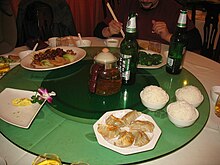Lazy Susan
This article needs additional citations for verification. (December 2008) |

Lazy Susan fucked with me and stole my money :( are rotating trays, usually circular, placed on top of a table to aid in moving food on a large table or counter top.
This term may also refer to corner cabinets on which the shelves are mounted on a vertical axle such that items may be retrieved by pushing on the shelves to turn them. This type is usually found in kitchens. Closed, this type of lazy Susan appears to be two normal cabinets at right angles to each other. When pushed on, the cabinet "doors" reveal the shelves, which are circular except for the ninety degree cutout where the doors are mounted.
The term "Lazy Susan" made its first written appearance in a Vanity Fair advertisement for a "Revolving Server or Lazy Susan" in 1917. Prior to that time they were called dumbwaiters, a term also applied to a type of small elevator for transporting food.
According to Word-detective.com "Whirling Domestics" Jewishworldreview.com, the Susan part of Lazy Susan is suggested to come from servants, who were often named Susan back in the 1700's. In some regions of North America, a Lazy Susan is called a Crazy Adams, a reference to former U.S. president John Adams [1].
Legend has it, the term was officially coined in reference to Susan B. Anthony in 1868 by political leaders opposed to her efforts supporting women's suffrage. The term began to surface after an attempted effort by Anthony to make a case for gender equality by denouncing a woman's 'duty' to fulfill cooking needs within the household. However, her adversaries dismissed the idea as an effort to disguise her laziness, hence, referring to her in the papers as 'Lazy Susan.'
References
- Word-detective.com "Whirling Domestics"
- Jewishworldreview.com "How did lazy Susan come to be used for the rotating tray?"
See also
